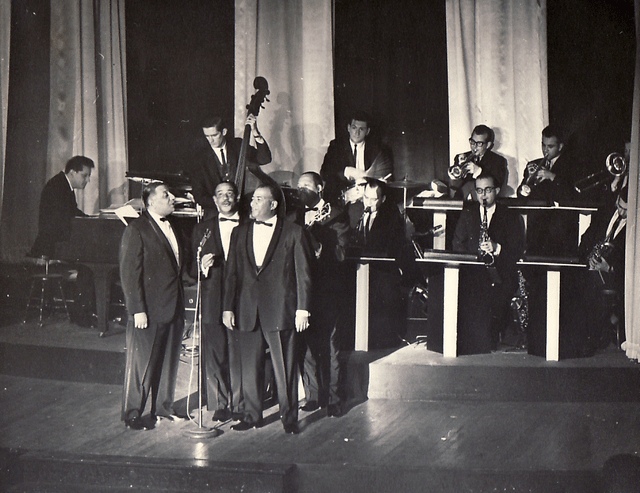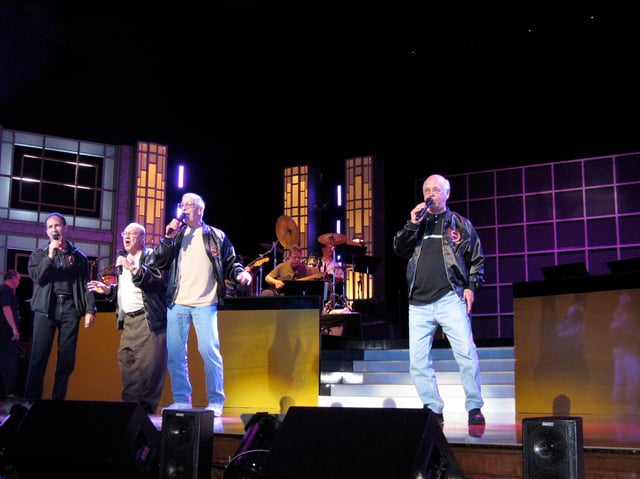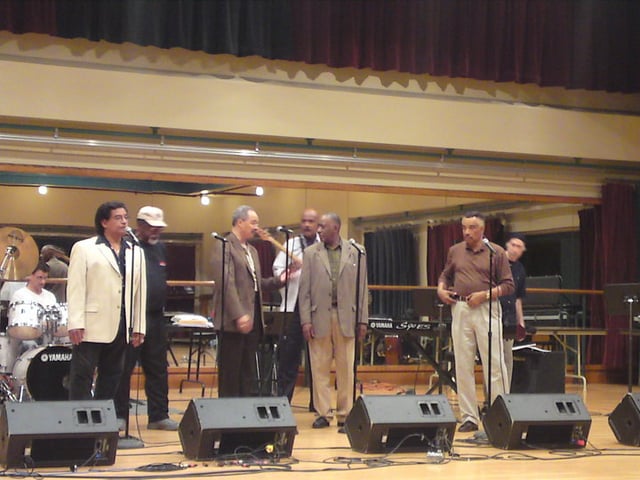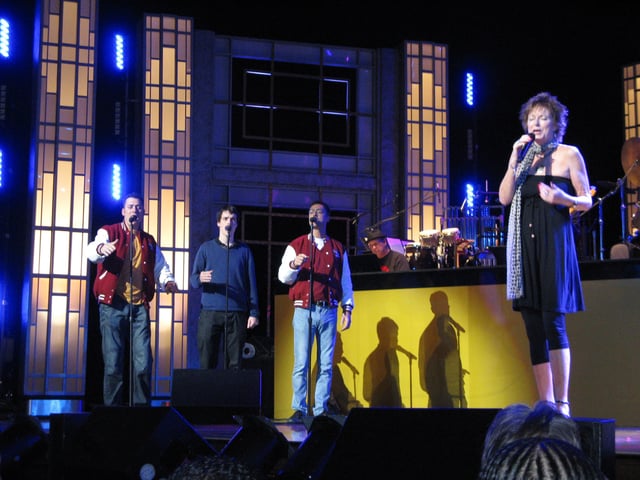Doo-wop

Doo-wop

| Doo-wop | |
|---|---|
| Stylistic origins |
|
| Cultural origins | 1940s–1950s, African-American communities across some major cities on the East Coast |
| Typical instruments |
|
| Derivative forms |
|
| Regional scenes | |
| |
| Other topics | |
| 50s chord progression | |
Doo-wop is a genre of rhythm and blues music developed in the 1940s by African American youth, mainly in the large cities of the upper East Coast, including New York. It features vocal group harmony that carries an engaging melodic line to a simple beat with little or no instrumentation. Lyrics are simple, usually about love, ornamented with nonsense syllables, and often featuring, in the bridge, a melodramatically heartfelt recitative addressed to the beloved. Gaining popularity in the 1950s, doo-wop enjoyed its peak successes in the early 1960s, but continued to influence performers in other genres.[1]
| Doo-wop | |
|---|---|
| Stylistic origins |
|
| Cultural origins | 1940s–1950s, African-American communities across some major cities on the East Coast |
| Typical instruments |
|
| Derivative forms |
|
| Regional scenes | |
| |
| Other topics | |
| 50s chord progression | |
Origins
Doo-wop has complex musical, social, and commercial origins.
Musical precedents

A typical doo-wop chord progression in C major
Doo-wop's style is a mixture of precedents in composition, orchestration, and vocals that figured in popular music by composers or groups both black and white from the 1930s to the 1940s.
Such composers as Rodgers and Hart (in their 1934 song "Blue Moon"), and Hoagy Carmichael and Frank Loesser (in their 1938 "Heart and Soul") used a I-VI-II-V-loop chord progression in those hit songs; composers of doo-wop songs varied this slightly but significantly to the chord progression I–VI–IV–V, so influential that it is sometimes referred to as the 50s progression. This characteristic harmonic layout was combined with the AABA chorus form typical for Tin Pan Alley pop.[2]
Hit songs by black groups such as the Ink Spots[3] ("If I Didn't Care", one of the best selling singles worldwide of all time, and "Address Unknown") and the Mills Brothers ("Paper Doll", "You Always Hurt The One You Love" and "Glow Worm")[4] were generally slow songs in swing time with simple instrumentation. Doo-wop street singers generally performed without instrumentation, but made their musical style distinctive, whether using fast or slow tempos, by keeping time using a swing-like off-beat, while using the doo-wop syllables as substitute for drums and a bass vocalist as substitute for a bass instrument.
Doo-wop's characteristic vocal style was influenced by groups such as the Mills Brothers, whose close four-part harmony derived from the earlier barbershop quartet.
Elements of doo-wop vocal style
Bill Kenny, lead singer of the Ink Spots, is often credited with introducing the "top and bottom" vocal arrangement featuring a high tenor singing the lead and a bass singer was singing rhythm. The Mills Brothers, who were famous in part because in their vocals they sometimes mimicked instruments, exercised an additional influence on street doo-woppers who, singing a cappella arrangements, used wordless onomatopoeia to mimic instruments, the bass singing "bom-bom-bom," a guitar rendered as "shang-a-lang," and brass riffs as "dooooo -wop-wop." For instance, "Count Every Star" by The Ravens (1950) includes vocalizations imitating the "doomph, doomph" plucking of a double bass. The Orioles helped develop the doo-wop sound with their hits "It's Too Soon to Know" (1948) and "Crying in the Chapel" (1953).
Origin of the name
Although the musical style originated in the late 1940s and was wildly popular in the 1950s, the term "doo-wop" itself did not appear in print until 1961, in The Chicago Defender, just as the style's vogue was nearing its end. Though the name was attributed to radio disc jockey Gus Gossert, he did not accept credit, stating that "doo-wop" was already in use in California to categorize the music.[5]
"Doo-wop" is itself a nonsense expression. In The Delta Rhythm Boys' 1945 recording, "Just A-Sittin' And A-Rockin", it is heard in the backing vocal. It is heard later in The Clovers' 1953 release "Good Lovin'" (Atlantic Records 1000), and in the chorus of Carlyle Dundee & The Dundees' 1954 song "Never" (Space Records 201). The first record to use "doo-wop" in the refrain was The Turbans' 1955 hit, "When You Dance" (Herald Records H-458).[5] The Rainbows embellished the phrase as "do wop de wadda" in their 1955 "Mary Lee" (on Red Robin Records; also a Washington, D.C. regional hit on Pilgrim 703); and in their 1956 national hit, "In the Still of the Night," The Five Satins[6] enlivened the bridge with a plaintive "doo-wop, doo-wah."
Eventually the term's application was extended to include rhythm and blues groups.
Development

The Quotations live in concert at the Benedum Center, Pennsylvania
The Chords' 1954 hit, "Sh-Boom," is considered to have been the first rhythm-and-blues record to break into the top ten on the Billboard charts, reaching #9; a few months later, a white group from Canada, the Crew Cuts, released their cover of the song, which reached #1. Quickly, other R&B vocal groups entered the pop charts, particularly in 1955, which saw such cross-over doo-wop hits as "Sincerely" by The Moonglows,[7] "Earth Angel" by The Penguins, The Cadillacs "Gloria", The Heartbeats "A Thousand Miles Away", Shep & the Limelites "Daddy's Home", The Flamingos "I Only Have Eyes for You", The Jive Five "My True Story".[8] Doo wop uptempo groups such as The Monotones" Book of Love",[9] "Get a Job" by The Silhouettes, The Marcels " Blue Moon" got hits on Billboard chart. All-white doo-wop groups would appear and produce hits: The Mello-Kings in 1956 with "Tonight, Tonight," The Diamonds in 1957 with the chart-topping cover song "Little Darlin'(original song by AfroAmerican group)", The Skyliners in 1959 with "Since I Don't Have You", " The Tokens in 1961 with "The Lion Sleeps Tonight".
Particularly productive were doo-wop groups of young Italian-American men who, like their black counterparts, lived in rough neighborhoods (e.g. the Bronx and Brooklyn), learned their basic musical craft singing in church, and would gain experience in the new style by singing on street corners. By the late 1950s and early 60s, many Italian-American groups had national hits: Dion and the Belmonts scored with "I Wonder Why," "Teenager in Love," and "Where or When"; The Capris made their name in 1960 with "There's a Moon Out Tonight"; Randy & the Rainbows, who charted with their Top #10 1963 single "Denise"; and with the Beach Boys the only other American band who enjoyed success both before, during, and after the British invasion, The Four Seasons had pop hits with "Rag Doll", "Come on Marianne" and many others. Other Italian-American doo-wop groups were The Earls, The Chimes, The Elegants, The Mystics, The Duprees, Johnny Maestro&The Crests, and The Regents.
Some doo-wop groups were racially mixed. Puerto Rican Herman Santiago, originally slated to be the lead singer of the Teenagers, wrote the lyrics and the music for a song to be called "Why Do Birds Sing So Gay?", but whether because he was ill or because producer George Goldner thought that newcomer Frankie Lymon's voice would be better in the lead, Santiago's original version was not recorded, because to suit his tenor voice Lymon made a few alterations to the melody, and so the Teenagers recorded the song known as "Why Do Fools Fall in Love?". Margo Lopez Sylvia was lead singer for the Tune Weavers. Chico Torres was a member of the Crests, whose lead singer, Johhny Mastrangelo, would later gain fame under the name Johnny Maestro. Racially integrated groups with both black and white performers included The Del-Vikings, who hit big in 1957 with "Come Go With Me" and "Whispering Bells", The Crests, whose "16 Candles" appeared in 1958, and The Impalas, whose "Sorry (I Ran All the Way Home)" was a hit in 1959.
Female doo-wop singers were unusual in the early days. Lillian Leach, lead singer of the Mellows from 1953 to 1958, helped pave the way for other women in doo-wop, soul and R&B.[10] Other female doo wop groups were The Chantels and the Royalettes.
Popularity

The Cleftones during their participation in the doo-wop festival celebrated in May 2010 at the Benedum Center.
Doo-wop groups achieved 1951 R&B chart hits such as "Sixty Minute Man" by Billy Ward and His Dominoes, "Where Are You?" by The Mello-Moods, "The Glory of Love" by The Five Keys, "Shouldn't I Know" by The Cardinals.
In 1954, doo-wop groups played a significant role in ushering in the rock and roll era when two big rhythm and blues hits by vocal harmony groups, "Gee" by The Crows and "Sh-Boom" by The Chords, crossed over onto the pop music charts. "Only You" by pop group The Platters.[11] The same year saw a number one pop chart hit, "The Great Pretender" by The Platters.[12] In 1956, Frankie Lymon and The Teenagers appeared on the Frankie Laine show in New York, which was televised nationally, performing their hit "Why Do Fools Fall in Love?". Frankie Laine referred to it as "rock and roll"; Lymon's extreme youth appealed to a young and enthusiastic audience. His string of hits included: "I Promise to Remember", "The ABC's of Love" and "I'm Not a Juvenile Delinquent".
The peak of doo-wop might have been in the late 1950s. Early 1960s with the most notable hits being Dion's "Runaround Sue", "The Wanderer", "Lovers Who Wander" and "Ruby Baby" and The Marcels' "Blue Moon". There was a revival of the nonsense-syllable form of doo-wop in the early 1960s, with popular records by The Marcels, The Rivingtons, and Vito & the Salutations. The genre reached the self-referential stage, with songs about the singers ("Mr. Bass Man" by Johnny Cymbal) and the songwriters ("Who Put the Bomp?" by Barry Mann), in 1961.
Doo-wop's influence
Other pop R&B groups, including The Coasters, The Drifters, The Midnighters, and The Platters, helped link the doo-wop style to the mainstream, and to the future sound of soul music. The style is heard in the music of The Miracles, particularly in their early hits such as "Got A Job" (an answer song to "Get a Job"),[13] "Bad Girl", "Who's Loving You", "(You Can) Depend on Me", and "Ooo Baby Baby". The style is also heard in the early days of The Famous Flames, led by James Brown; the group recorded several doo-wop hits, including "Please, Please, Please", "Oh Baby Don't You Weep", "Bewildered", "I Don't Mind", and their hit cover of The "5" Royales' "Think all entering the Top 10, as well as R&B Number #1 Try Me.
Doo-wop's influence continued in soul, pop, and rock groups of the 1960s. Doo-wop was a precursor to many of the African-American musical styles seen today. Evolved from pop, jazz and blues, doo-wop also influenced many of the major rock and roll groups that defined the later decades of the 20th century. Doo-wop laid the foundation for many musical innovations.
Doo-wop's influence continued in soul, pop, and rock groups of the 1960s, including The Four Seasons, girl groups, and vocal surf music performers such as the Beach Boys. In the Beach Boys' case, the doo-wop influence is evident in early hit "Surfer Girl", and in albums recorded within their psychedelic era, during which the group experimented and innovated with the human voice as an instrument[14] in a self-described effort to "expand modern vocal harmony".[15]
Revivals

Kathy Young with The Earth Angels performing Kathy's hit A Thousand Stars during the festival of this genre celebrated at the Benedum Center for the Performing Arts in Pittsburgh, Pennsylvania, in May 2010
At various times in the 1970s, 1980s, and 1990s, the genre has seen revivals. Main artists are concentrated in urban areas (e.g., New York City, Chicago, Philadelphia, Newark, and Los Angeles). Revival television shows and boxed CD sets (e.g., DooWop Box 1–3) have kindled interest in the music, the artists, and their stories. In December 1968, Frank Zappa's band The Mothers of Invention released a doo-wop parody/tribute album called Cruising with Ruben & the Jets.[7] An early notable revival of "pure" doo-wop occurred when Sha Na Na appeared at the Woodstock Festival. Soul group The Trammps recorded"Zing! Went the Strings of My Heart" in 1972.
Over the years groups have remade doo-wop songs, with great success. Late 1970s, by the group Darts, who successfully revived doo-wop standards such as "Daddy Cool", "Come Back My Love".
Other artists had doo-wop or doo-wop-influenced hits in later years, such as Robert John's 1972 version of "The Lion Sleeps Tonight", Toby Beau's 1978 hit "My Angel Baby", and Billy Joel's 1984 hit "The Longest Time". Soul and funk bands such as Zapp ("Doo Wa Ditty (Blow That Thing)") released New style Doo Wop. The last doo-wop record to reach the top ten on the U.S. pop charts was "It's Alright" by Huey Lewis and the News, a cover of The Impressions' 1963 Top 5 smash. It reached number 6 on the U.S. Billboard Adult contemporary chart in June 1993. D.R.S "Gangsta Lean" and After 7 "Nights like This", Coming of Age "Coming Home to Love" have some doo-wop elements as well. Much of the album contained a doo-wop flavor. Another song from the By The Way sessions to feature a doo-wop influence was a cover of "Teenager In Love", originally recorded by Dion and The Belmonts. Mr. Bungle also displayed doo-wop influences on their final album, California, particularly on the song "Vanity Fair".
Doo-wop is popular among barbershoppers and collegiate a cappella groups due to its easy adaptation to an all-vocal form. Doo-wop, at the turn of the millennium, experienced a resurgence in popularity, with PBS's doo-wop concert programs: Doo Wop 50, Doo Wop 51, and Rock, Rhythm, and Doo Wop. These programs brought back, live on stage, some of the better known doo-wop groups of the past. In addition to The Earth Angels, doo-wop acts in vogue in the second decade of the 21st century range from The Four Quarters[16] to Street Corner Renaissance.[17] The ultimate longevity of doo-wop has been disputed.[18][19]
Bruno Mars and Meghan Trainor are two examples of current artists who incorporate doo-wop music into their records and live performances. Mars says he has "a special place in [his] heart for old-school music".[20] The doo-wop scene of the 1950s strongly parallels that of the formation of the hip-hop scene beginning in the late 1970s, but particularly mirroring the emergence of the culture of the 1990s in that "it is (in its authentic form) a non-commercial street music pursued by the group, for the group (African Americans). In a broader context, it involves a male-competitive form of dancing (breaking), its own private slang and dress code, as well as other related emotive forms, such as graffiti art."[21]
See also
List of doo-wop musicians
Scat singing
Vocalese
50s progression, also known as the "Doo-wop" progression
Boogie
